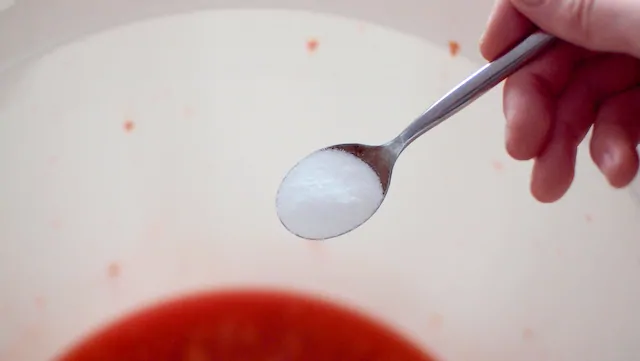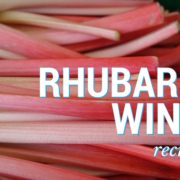Rhubarb Wine Recipe – How to Make A Delicious Rhubarb Wine

Rhubarb wine is actually a vegetable wine, although, rhubarb is a vegetable that is almost always used like you would a fruit.
The sharp tartness is a great quality that really shines through in a country wine so this rhubarb wine recipe is a definite winner.
Most people will be familiar with rhubarb in the form of rhubarb Crumble.
Table of Contents
Balance Acidity In Rhubarb Wine
Plenty of sugar helps to restrain the acidity and tartness of the rhubarb. If you like the taste of rhubarb then you’ll be pleased to know the flavour comes through in the finished wine.
The reason why rhubarb is so tart is that the stems contain an excess amount of oxalic acid.
This is also the reason why some people have an aversion to rhubarb. Too much oxalic acid is bad for wine yeast and may result in poor fermentation so we will take this into account when preparing the recipe.
Reducing the amount of acid is a fairly simple process of making a small addition of chalk which causes a reaction and reduces the acidity in the wine. Apart from this one small step, the process is the same as almost any country wine recipe.
It should be noted that rhubarb leaves should not be used in wine or eaten. The levels of oxalic acid are far too high and can in fact be poisonous (you would have to eat a lot for it to be problematic).
The stems are perfectly edible and can be used in the wine. Rhubarb is always sold without leaves so it’s only really an issue if you are picking your own rhubarb..

Using Rhubarb In A Wine
Rhubarb has two crops in a year, the first crop is forced rhubarb and is grown earlier in the year, around January to February.
The stems and leaves are grown under pots and the result is a pale pink stem that is more delicately flavoured and tender.
The second crop of rhubarb is grown outside and arrives from late March until June, the resulting crop is slightly hardier and darker in colour and contains more oxalic acid than the forced rhubarb.
This stronger flavour may be less desirable to cook with but is still great to make wine with.
Later in the season, some rhubarb stems can become a bit tough and stringy which makes these stems less desirable to eat but still fantastic to make wine with. If you grow rhubarb yourself then consider using the larger and tougher stems to make wine.
Making Rubarb Wine
What You’ll Need To Make Rhubarb Wine – Makes 1 gallon / 4.5 litres
The equipment you’ll need to make this rhubarb wine is fairly straightforward if you’ve made wine before you may have everything you need below:
- Fermenting Bucket
- Demijohns
- Large Pan
- Syphon
- Fine Straining Bag
- Airlock & Bung
Rhubarb Wine Recipe Ingredients
- 1.5kg – 2kg of Rhubarb Stalks
- 1.2kg Sugar
- 250g Chopped Raisins
- 1/4 tsp Wine Tannin
- 1/2 tsp Pectic Enzyme
- 1 tsp Yeast Nutrient
- 1 Campden Tablet
- 1 tsp Calcium Carbonate (Precipitated Chalk)
Rhubarb Wine Method
- In a clean and sanitised fermentation bucket add the rhubarb stalks cut up into inch pieces and chopped raisins to a straining bag. Break up the rhubarb slightly with the end of a rolling pin, just enough to split the stalks, you don’t need to completely mash them.
- In a pan combine the sugar with 1.9 litres of water and bring to the boil. Once boiling turn off the heat and pour over the ingredients in the straining bag. Top up the fermenter with cold water to 4.5 litres in total. When the mixture is cool add the Campden tablet, stir thoroughly and let stand for 48 hours.
- After 48 hours lift out the straining bag and squeeze out the juice. Into the remaining liquid add 1/4 tsp of Calcium Carbonate (Precipitated Chalk) every 30 minutes stirring thoroughly. The mixture will fizz as the chalk reacts with the oxalic acid.
- After this step add the pectic enzyme, stir and leave for 24 hours.
- After 24 hours add the tannin along with the yeast nutrient, mix thoroughly and then sprinkle the yeast on the surface of the must.
- Allow to ferment for two weeks before racking to a demijohn to allow the wine to condition and clear. Leave in the demijohn for a few months until completely clear racking to a new demijohn when necessary. Check these steps for more information on racking and maturing wine.
- Rhubarb wine is best left for the best part of a year before enjoying, maybe open a bottle once every few months to see what I mean.




Hi, step 3 says to add calcium carbonate every 30 minutes but it doesn’t say how many times, could you clarify please? Thank you.
You need to add 1 tsp in total. The additions can be added 1/4 tsp at a time every half an hour or over the course of your day when you get a chance.
Hope this helps.
Hello, is the precipitated chalk used to reduce the oxalic acid?
Yes, that’s right. It will help to neutralise some of the acids in the rhubarb.
Hi, wondered what sort of strength. The finished wine would be ?
Thank you
Hi Alwyn,
The sugar addition of 1.2kg in this recipe would give a starting gravity of 1.090. Fermented out fully the ABV of the wine would be around 11.8% – 12%. There will also be some sugars contributed by the rhubarb so it may ever so slightly higher.
The recipe headline indicates 4.5 litres is produced, however the method refers only to starting with 1.9 litres of water. Can anyone clarify (excuse the pun)?
Sorry about this not being clear. Once you have added the boiling water over the rhubarb and allowed to steep for a few minutes top up the fermenter with cool water to the final volume.
This brings the temperature down quickly and allows the process to continue.
Hope this helps
This brings the temperature
Hi Neil,
I’m ready to add yeast to my brew and have a pH of 3.5. If I reduce the oxalic acid as you describe, should I add an acid blend to compensate and if so, what pH do you recommend I balance it to? Thanks..
In general a white wine must tends to have a pH below 3.3 and a red wine must is usually below 3.4. Rhubarb tends to be quite pale but you can always adjust the acid after sampling the wine after fermentation if you think it needs it.
Hope this helps.
Is there a particular reason why you advise waiting 2 weeks before transferring to a demijohn in this recipe, whereas your blueberry recipe was 1 week?
There is no particular reason. I usually rack between 7 -14 days depending on how busy I am and just followed the notes for when I last made Rhubarb wine.
Hi, trying out this rhubarb wine recipe for the first time and have just lifted the soaked rhubarb out of the fermentation bucket. After squeezing I’m only left with just over 3 litres of liquid which is a bit disappointing. Any tips for next time so I can get more liquid?
Hmm, I am not sure why this is. In future batches you can increase both the water and sugar additions by 10 – 15% to make up for the losses to the rhubarb.
Hi,
we have some rhubarb frozen from an earlier picking (this year) – could this be used to make Rhubarb wine? Would it have any impact on the flavour etc? It was washed, chopped and frozen.
Thanks!
Frozen rhubarb is perfect. Freezing actually helps to break down the cell walls in the stems and extract more juice. The flavour will be exactly the same. Hope it turns out well for you.
Hi Neil,
Yeast isn’t on the list of ingredients!
How much do I need per kg rhubarb or per 4.5litres of water? (I’m making a double batch.)
Tanya
Oh dear, you will need one sachet of 5 – 7 grams for a double batch.
There are two acids in rhubarb.
The leaves have Oxalic acid at amounts high enough to make them inedible, but a 65 kg adult would probably need to eat 4 to 8 kg to have a 50% chance of dying.
The stems contain mostly Malic acid, which is harmless. They have some Oxalic acid but not enough to be a problem.
See:
https://en.wikipedia.org/wiki/Rhubarb
https://en.wikipedia.org/wiki/Oxalic_acid (Content in food items)